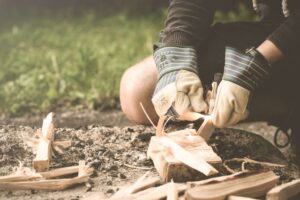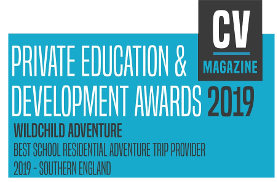5 ways to get more from your School Bushcraft Trip
This year has made us appreciate time spent outdoors in nature. What better way to promote outdoor learning than with a bushcraft trip for your students?
Bushcraft trips help develop:
- Resilience
- Team-building skills
- Peer friendships
- Problem-solving abilities
- A love of nature
Children explore fun survival skills like fire lighting and shelter building, whilst learning how to work together as a team.
Bushcraft trips take a lot of organising, so you want to make it worthwhile. Make your bushcraft adventure the centre of your curriculum rather than a bolt-on extra. We’ve got five practical ideas to help you make the most out of your adventure.
1: Plan for your bushcraft trip
Running a successful school trip relies on good planning. Thinking about all those ‘what ifs’ before you depart means you can relax and enjoy the experience as much as your students.
All reputable trip providers are happy for you to come and visit before your bushcraft trip begins. Most will encourage you to do so. Meet the trip leader and get familiar with the location. This is the perfect opportunity to ask any questions. Make sure you feel confident that every part of the trip has been well planned.
Write a risk assessment
Think the unthinkable to ensure you’ve planned for every risk. Lots of school trip organisers have sample risk assessments you can tailor to the needs of your school. Wildchild instructors are all first aid trained with DBS checks. Make sure your provider has the same high standards. Think about the adult-child ratio you need, and which members of staff have first aid training.
Plan your activities
Every bushcraft trip company works differently. Check you know exactly what activities your students will experience. If you get to choose, make your selections in in good time and check the company has received them. You don’t want your students to miss out.
Create a timeline
Bushcraft trips are easily managed if you spend just a little time planning what you need to do by when. Write to parents early to give them time to make payments and collect any essential equipment their child needs. Check off each stage of your trip planning, to keep you on track.
2: What to pack for bushcraft trips
There’s no need for all the parents to buy new clothing. Arrange a second-hand sale or swap shop at your school to encourage them to reuse items and save money. Send out an equipment list that explains exactly what they need (and don’t need) to bring.
Bushcraft trip clothing
Your class need warm, comfortable clothing they can easily move around in. Trousers should be sturdy, and they’ll need shoes or boots with good grip. British weather is notoriously unpredictable, so preparing for rain is essential with a good set of waterproofs.
It’s a good idea for your class to bring a spare set of clothes with them. That way no one’s forced to spend the day in wet socks. If you’re staying on a residential, ask parents to provide extra set of clothes to change into as needed.
Essentials to bring on your bushcraft trip
Every student will need a small bag to carry everything in, unless your trip provider asks otherwise. Encourage students to make them as small as possible and arrange for a place to leave them, so they don’t drag them around all day.
Most trips will tell you what your students should bring but ask if you’ve not sure. P arents will want to know:
arents will want to know:
- Will they need spending money?
- Can they bring electronic games and phones?
- Should they bring a water bottle and snacks?
Remember to bring any medication your students need along with a first aid kit. Tell your adult helpers where they are kept in case of emergency. Don’t forget to bring copies of your class list, groupings, and risk assessment.
You’ll be surprised how many teachers forget to prepare their camera or phone ready to take photos. Clear enough memory and make sure yours is fully charged. These images make a great resource back in the classroom.
Residential bushcraft trips
If you’ve booked a longer stay, you’ll have a more substantial equipment list. Your trip provider should tell you exactly what you and your students need to bring.
Remember to include:
- Sleeping bag
- Wash kit containing toothbrush, paste, and soap
- Pyjamas
- Torch
- A plastic bag for wet clothing
- Anything else your provider recommends
Whilst the children are in charge of their own equipment, it’s sensible to prepare for the worst and bring a few spare items. Check where you can leave these, so you don’t end up stuck carrying them all the time.
3: Taking bushcraft trips back to the classroom
The children can share what they’ve learnt on their trip with the rest of the school. They’ll be excited to tell everyone about the skills learnt and fun they’ve had.
You could plan a:
- Special assembly for parents
- Class book
- Presentation for younger students
- Report put on the school website
- Reviews for the school’s social media accounts
Don’t waste the opportunities your bushcraft trip brings. Instead of a bolt-on extra, make your trip central to classroom learning. It makes a great launch event for a new unit of work and gives you inspiration for exciting writing and other creative opportunities.
4: Reflecting on your school bushcraft trip
At Wildchild, teachers tell us their children mature by being away from school. They develop in confidence and build stronger bonds with each other. Plan time for your class to talk about their adventure and think about how it’s affected them.
You’ll want to reflect on your bushcraft trip too. Think about what went well, the activities your class loved, and what to change for next time. Remember to talk to other staff and parent helpers to collect their impressions too.
5: Look for new bushcraft opportunities
Why should the bushcraft adventure stop when you get back to class? Look for ways to promote outdoor learning in your school.
You could try:
- Starting a bushcraft club
- Learning more about survival skills
- Planning outdoor learning days
- Visiting outdoor locations close to school
- Reviewing your curriculum to provide more outdoor learning opportunities
In summary
Bushcraft trips are a wonderful opportunity to get your class out into nature and enjoying time spend in the wild. Good planning and clear communication with the trip provider, parents, and school staff will ensure everything goes smoothly.
But don’t let it stop there. Embed your bushcraft experience back into classroom learning. Use your bushcraft trip to launch a new unit of work and look for opportunities to update your curriculum centred on outdoor learning.
Wildchild offer award-winning bushcraft trips conveniently close to London and the M25. Click here to find out how we can create the perfect bushcraft trip experience for your school.
Recent Posts
- Why you should be insisting on LOtC for your school residential trips
- The impact of Nature deficit disorder and the preventative role schools can play
- Residential trips for secondary schools to ease transition
- Building character through primary school trips
- Six reasons why more schools are choosing UK school trips (spoiler alert: it’s not because of Covid!)
- School trips after the pandemic
- 5 winter outdoor learning activities for schools
- 5 ways to get more from your School Bushcraft Trip
- Residential trips to benefit learning
- Perfect Primary School Trip Planning
Blog home







